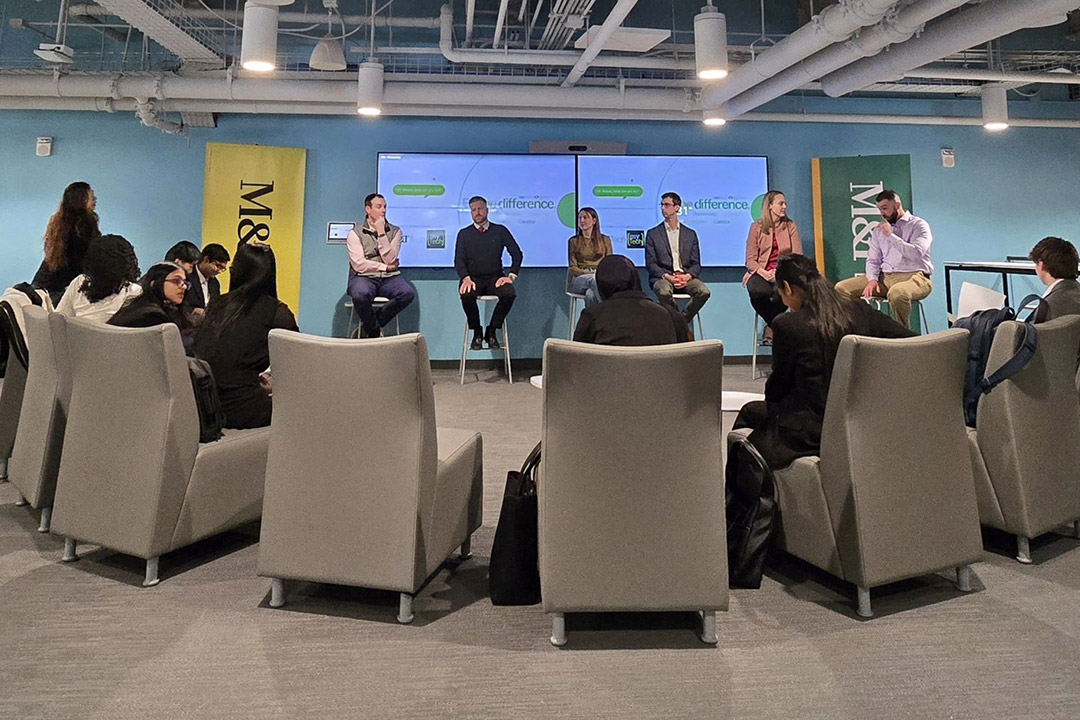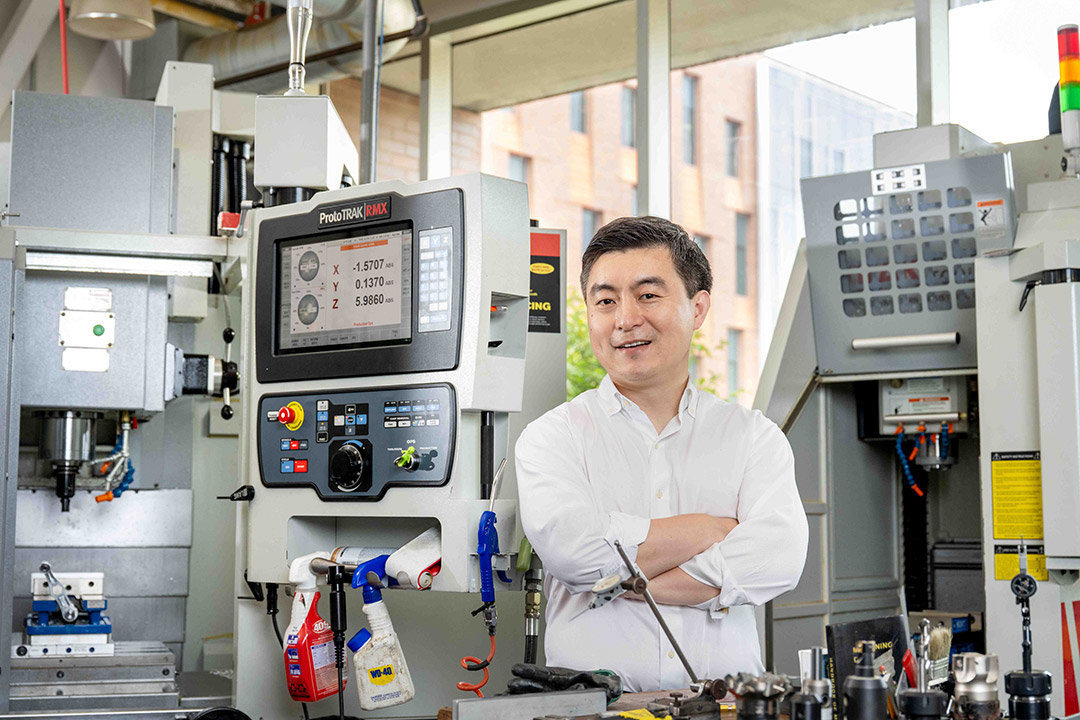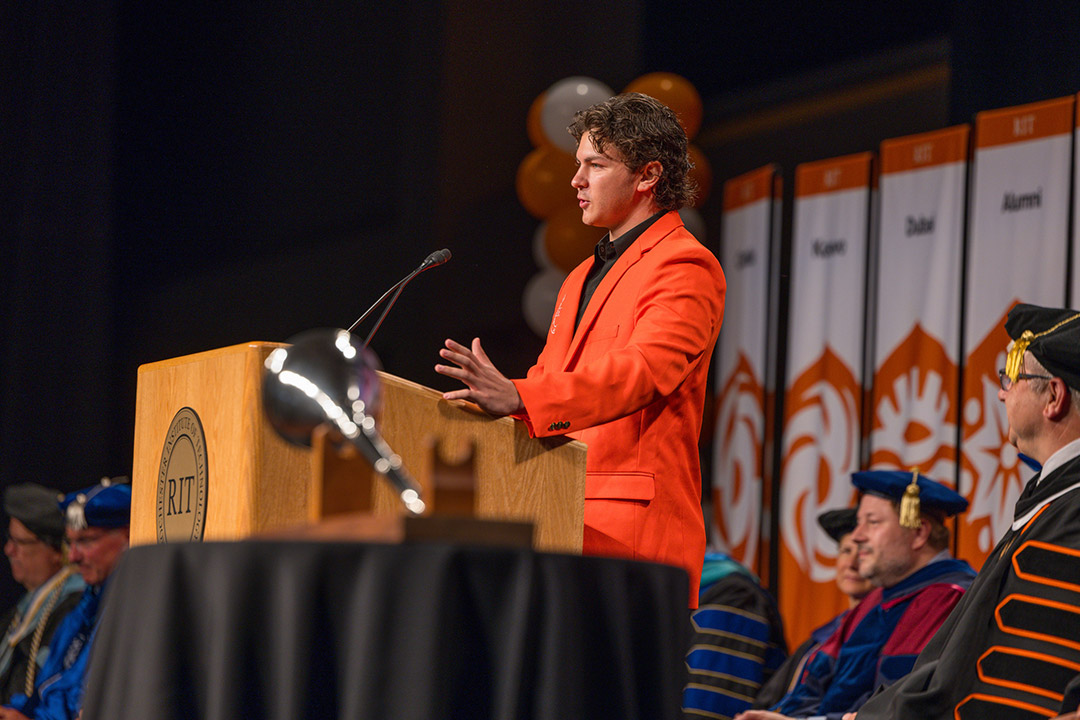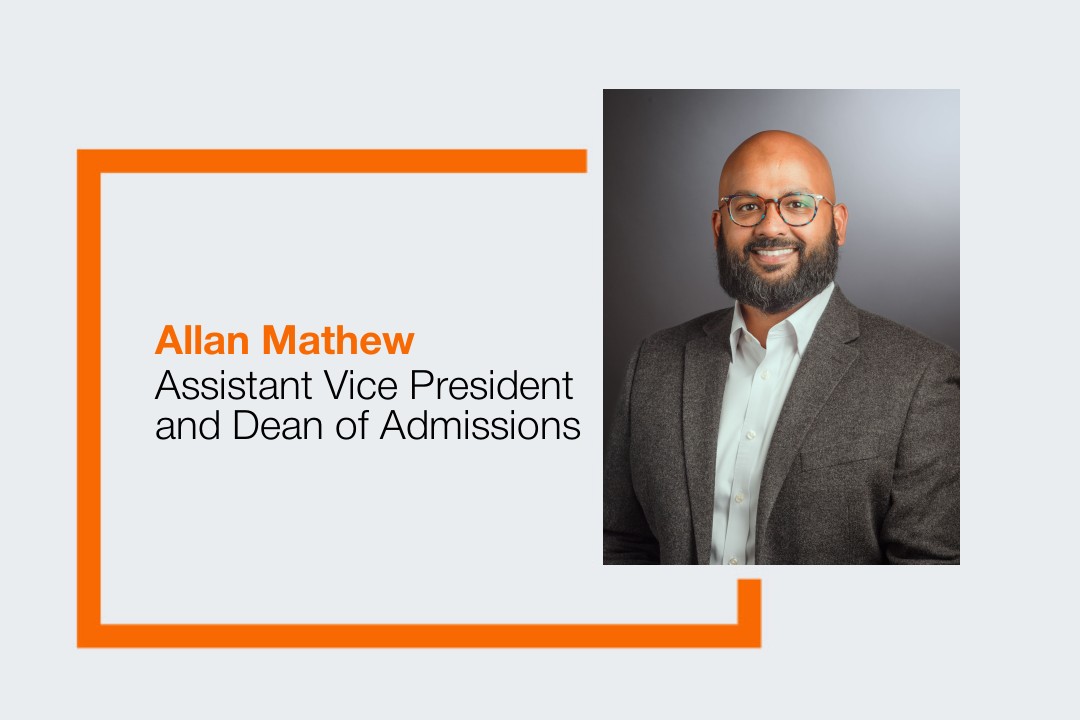Traveling Tigers connects Saunders students with career opportunities
A program at Saunders College of Business is helping students gain real-world immersion into the careers they study. The Traveling Tigers program bridges gaps for students between classroom learning and career launching. Saunders students have been visiting a wide array of local and regional organizations to learn about varied business careers across disciplines.
In 2024, building upon this program, Archana Jain, department chair for finance and accounting, began organizing Traveling Tigers visits focused specifically on those interested in opportunities in finance and accounting, as part of a broader push to increase industry exposure.
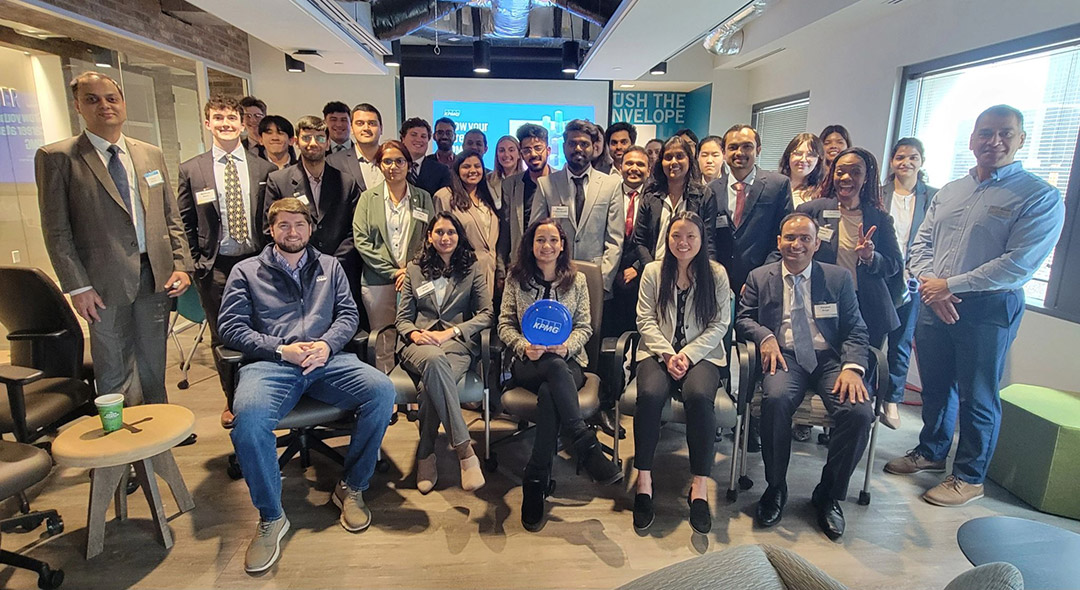
Provided
Archana Jain, front and center, poses with a group of students and staff on a visit to KPMG during a Traveling Tigers event in 2024.
Each semester, Jain works through Saunders’ advisory boards and corporate partners to arrange a three-to-four-company tour over the course of a day. Students spend about two hours at each site, meeting different staff and human resources leaders, hearing presentations on corporate culture and skill needs, and touring facilities.
“They can get a basic view of the culture of these companies, what it really means to work in, say, an accounting or finance firm,” said Jain. “They get to compare and see the differences in culture and expectations. They also learn about the pathways available to interns or new hires, like rotation programs. In just one day, they get a clear sense of what it means to work in the field.”
The response from industry has been strong. After one of the first visits, Jain shared a post on LinkedIn that drew positive feedback from two companies, both eager to host future tours.
“The accounting world is facing a shortage of talent, so these visits give employers a chance to meet students and showcase their culture,” said Jain. “The companies go all out and roll out the red carpet for us. On one visit they even made special cookies to welcome the Tigers. It’s a good way for both sides to connect.”
Over the last year, students have visited regional firms including Culov Wealth Management, M&T Bank, Delaware North, MMB+CO, Allied Financial Services, Freed Maxick, and PwC. The results have been positive, as some students have received internship or job opportunities afterwards. In one recent visit, a company hired five Saunders students as interns.
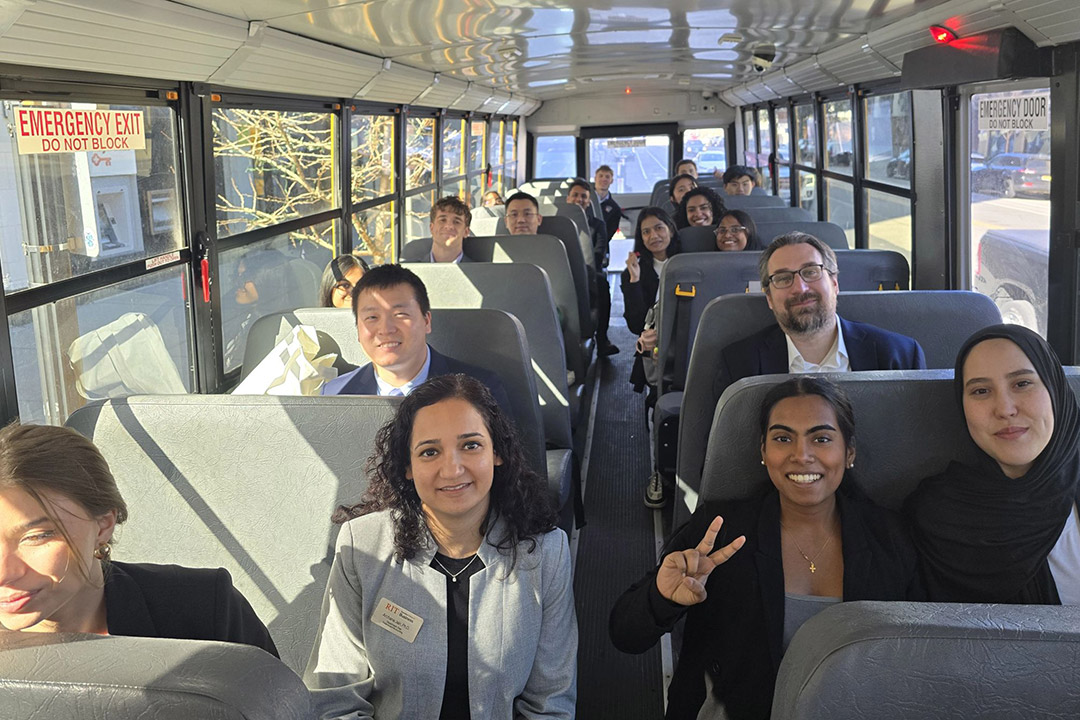
Provided
Transportation and visits to accounting and financial firms are made possible in part by donations through the Sentinel Society.
Spencer Dennis, a third-year accounting and finance major and honors student from Webster, N.Y., had a similar result.
“In my first year here, I fully intended on being a finance major, hopefully to be an investment banker or financial analyst for a bank,” Dennis said. “Upon visiting firms with Traveling Tigers, I realized I am made to be a CPA and to pursue a career that starts in public accounting.”
Dennis set his sights on joining a Big Four firm in Rochester. During a visit to PwC, he received a hat as a souvenir and promised himself he wouldn’t wear it until he earned an internship there. That visit gave him a foot in the door at PwC’s Rochester branch, turning him into a familiar face at RIT recruiting events. Last fall, he interviewed with a managing partner he had first met on that visit, and soon after received a lucrative offer.
Dennis indicated, that they typically bring on interns to hire them full time. “I have a spot saved for an associate position in January, which is super exciting,” he said. “Traveling Tigers helped make that possible; it allowed for a student like me who puts in 100% of effort into things to capitalize on that opportunity.”
The program is made possible through the generosity of donors, including support from the Sentinel Society, whose gifts help fund the travel and logistics needed for these site visits. At Saunders, Sentinel Society support has also enabled students to attend national conferences and competitions, expanding their professional exposure beyond the classroom.
“Programs like Traveling Tigers, along with opportunities to attend conferences and competitions, ensure that our students gain meaningful experiences outside of the classroom that can shape their careers and futures,” said Jacqueline Mozrall, dean of Saunders College of Business. “Fueled by alumni donations, Traveling Tigers has been expanded, with discipline-focused visits also happening in hospitality, supply chain, marketing, management information systems and analytics. We are deeply grateful to our donors for investing in our students and making these transformative opportunities possible.”
The next Accounting Traveling Tigers event is scheduled for Oct. 21 and will include visits to Insero, Paychex, EY, and DeJoy & Co. Space is limited to 20-30 matriculated students at Saunders.
Latest All News
- Mechanical engineering faculty member earns prestigious CAREER awardManufacturing resurgence in the U.S. will be strengthened by a skilled workforce, and RIT faculty-researcher Rui Liu will lead a collaborative effort throughout the Finger Lakes region to support these efforts. Liu was recently awarded a prestigious National Science Foundation CAREER award to further the advanced manufacturing workforce. The five-year proposal begins this fall and will consist of a comprehensive training initiative that bridges traditional manufacturing training programs with modern concepts of engineering product design and processes. Each discipline—traditional training (sometimes referred to as apprentice programs) and engineering education—brings specific skill sets to the advanced manufacturing industry. Liu means to build a bridge between the two that had not been done as extensively before to achieve a more efficient training model that delivers broader learning outcomes, and cultivates a highly skilled, stable workforce for the industry’s long-term growth. “What would be the best way to train individuals and what is the best way to use their knowledge?” said Liu, an associate professor of mechanical engineering in RIT’s Kate Gleason College of Engineering. “This is an exciting opportunity and a fairly new research direction. This new generation learns differently, and at the same time, in talking to industry leaders, they know what they need in the workplace. What is the best way for technology and people to grow together?” The NSF receives thousands of proposals yearly, and only 14-20 percent across all directorates of the U.S. agency are funded. RIT has 17 NSF CAREER award winners working at the university. Manufacturing represents 12 percent of the U.S. total Gross Domestic Product, and nearly 9 percent of the workforce is employed in a variety of manufacturing settings, according to the National Strategy for Advanced Manufacturing. Projected estimates suggest that by 2030, if the skills shortage is not addressed, there could be more than 2 million unfilled manufacturing jobs. As part of the project, Liu will deliver a broad manufacturing workforce plan, augmented by modern learning strategies to better understand the cognitive learning required to ensure professional level competencies by a next-generation workforce. The project aims to gain a fresh perspective on the significance of experiential knowledge in manufacturing applications and proposes an innovative experiential learning approach to enhance knowledge transfer in product design and manufacturing education. “This project seeks to advance a fundamental understanding of situated cognition and embodied cognition within manufacturing contexts and proposes an innovative experiential learning approach to enhance knowledge transfer in product design and manufacturing education,” said Liu. He also emphasized that the project, supported by the NSF’s focus on undergraduate STEM education, would add to foundational research about learning processes overall, and impact learning outcomes for undergraduate students who will make up the workforce. Liu’s current efforts build on previous research based in Rochester with its historical connection to a changeable manufacturing industry. Working with the Rochester Technology and Manufacturing Association as well as Monroe Community College, he discovered specific need areas. Those include improving inefficiencies in current training programs, and the need to move manufacturing education theory toward more practical experiences, including building opportunities for those in technical roles-- whether it is furthering educational opportunities or advanced responsibilities. Another focus will be on ensuring critical institutional knowledge from retiring workers is retained and becomes a baseline of common knowledge and practice in advanced manufacturing. This new work entails bringing together representatives from the K-12, community college, university, and business communities. All have been impacted by changes in manufacturing operations. Early collaborations among these groups are underway, including an industry workshop called Finger Lakes Advanced Manufacturing Education, where local industry and educational leaders discuss specific programming and training needs and work together to adapt curricula. Liu has also conducted several informational programs such as ManufactuRIT a summer camp for middle school students. “What I am trying to do is build a more collaborative effort, for example a pathway program, in such a way to promote some very good students who want to increase their learning so we will get a perfect workforce that has both hands-on experience and very good conceptual knowledge. That is our ideal destination.”
- Meet Rafael Gilboa, this year’s Student Government presidentRafael Gilboa, a fourth -year software engineering major from Pittsburgh, chose to attend RIT because of its strong reputation for co-ops, generous financial aid, and a renowned computing program. But he also discovered an abundance of opportunities with clubs and activities available outside of the classroom. As this year’s Student Government president, he wants to support the more than 300 student clubs and organizations on campus to make sure other students can find friends and community like he has. He’s played intramural badminton, pickleball, volleyball, and joined the sailing team. “One semester, I was on seven intramural teams,” he said. “I even learned how to play hockey here, something I didn’t expect to graduate with from a software engineering program.” Enabling more communication to students about opportunities is just one goal Gilboa and this year’s vice-president, Ana Paolini Carrano, a third-year biochemistry major from Miami, Fla., have in mind for this coming year. Other goals of their platform include increasing student input in academic planning and course management; expanding access to co-op and career opportunities for students in all fields; helping plan more fun events for students on campus; and continuing, completing, and communicating current programs in Student Government. “We know that change is hard to make, and that most students don’t have the time in their busy schedules to dedicate to this type of advocacy,” Gilboa said “That’s what we’re here for, and just because we know something is a long shot or may not be completed by the end of our term, doesn’t mean we aren’t going to try.” They’re already working to get messaging to students where they are rather than having students dig for information; developing an electronic ID “tap” program for making philanthropic fundraising easier; establishing a spring club fair; and extending the add/drop period. And even before they met for their first session, they’ve overseen the installation of free menstrual product dispensers in Campus Center and scheduled the setup of multiple outdoor trash cans for students to use. “We are going to do everything we can to make RIT a better place,” Gilboa and Paolini Carrano said during their campaign, “and that doesn’t just include our own new ideas, but making sure the work of past administrations is followed through.” Gilboa said he tried not to promise specifics when they ran “because we knew that we still had a lot to learn. We ran on our values and a commitment to trying our best and feel really appreciative that the message hit with the RIT student body.” Gilboa decided to run for president to help give back “to a school which has made such a large impact on me and where I’ve been able to find a lot of friends.” He’s grateful for his experience at RIT. He’s kept busy working as a bartender for RIT Catering, being a member of the RIT Launch Initiative performance team, holding leadership roles in the Student Alumni Alliance (now University Alumni Alliance), and Greek Life. He also enjoys competing in in the Quiz Bowl club and spending time in the gym. “RIT is a great school to go to,” he said. “There are a ton of available services and support out there, with a lot of people who are looking out for you. That doesn’t mean it can’t be better. If you have the space and time, get involved. And if you don’t, we’re here to help.”
- Big Shot 37 set to touch down at Buffalo Bills Highmark StadiumFor the next Big Shot, RIT Tigers will temporarily trade their orange and black for red, white, and blue. On Saturday, Oct. 11, the Big Shot will return for its 37th event to illuminate the Buffalo Bills Highmark Stadium. RIT and the Bills invite the community to shine a light on the interior of the stadium to document the iconic location before it closes, making way for a new stadium set to open in 2026. The event is free, family-friendly, and open to the public, but registration is required to participate. Volunteers are asked to arrive between 6:30 and 7 p.m. to get into position for the event. The registration link will be available in the coming weeks on the RIT Big Shot website. “This Big Shot will be an important event for Western New York as the Buffalo Bills are entering their final season in Highmark Stadium. It will commemorate the history of the stadium for many Bills fans and the public, while providing RIT with an opportunity to showcase both our creative and technological sides,” said Eric Kunsman, co-coordinator of the Big Shot and assistant professor for RIT’s National Technical Institute for the Deaf (NTID). He added, “This may be many individuals’ last chance to visit the stadium while helping us illuminate a piece of Western New York history. We need 6,000 people to help us create a magical photograph of the stadium. Bring your friends and make a new memory at Highmark Stadium before the lights go out for good.” RIT Big Shot, described as “painting with light,” engages student and community volunteers by asking them to use individual flashlights and light sources to illuminate a structure or location with light while the RIT Big Shot camera team captures an extended exposure image. It’s an annual, signature event for RIT’s College of Art and Design and NTID, and is led by the School of Photographic Arts and Sciences, which is nationally recognized for its degree programs. This will be the 37th RIT Big Shot event since the project began in 1987. Kunsman and co-coordinator Dan Hughes, lecturer in RIT’s School of Photographic Arts and Sciences, shared that the Big Shot photo taken this October will eventually hang in the new Highmark Stadium to help commemorate the field that has been home to the Bills since 1973. The stadium exhibition is made possible through a collaboration with CEPA Gallery, a contemporary photography and visual arts center in Buffalo. Hughes said he looks forward to celebrating the team and its vibrant, far-reaching community of fans through photography. “Nurturing our photography community has always been our purpose. It was the reason Big Shot began decades ago,” said Hughes. “Whether attendees are passionate about the Buffalo Bills or photography—or if you love both, like me—the shared excitement when the sun goes down and we paint the stadium with light is what will make this moment memorable.” This year’s Big Shot is made possible by partnering with the Buffalo Bills and CEPA Gallery. The event is sponsored by the School of Photographic Arts and Sciences, NTID’s Department of Visual Communication Studies, and Nikon. Further details and a registration link will be shared in the coming weeks. For more information and updates, go to the Big Shot website or the Big Shot Facebook page. About RIT Big Shot RIT’s School of Photographic Arts and Sciences started its Big Shot project in 1987 as a way to teach photography students about light and exposure. The event traveled to several national landmarks and twice crossed the Atlantic Ocean. Through their viewfinders, RIT Big Shot photographers have captured landmarks in the United States, such as Kodak Tower in Rochester; Churchill Downs in Louisville, Ky.; the Alamo in San Antonio; and the Smithsonian National Museum of the American Indian in Washington, D.C. Internationally, the RIT team has captured Pile Gate in Dubrovnik, Croatia, and the Royal Palace in Stockholm, Sweden.
- Alumni mentorship leads to new opportunitiesHaving the right networking connections can make or break a career in the film industry. Thankfully for Marica Joseph, there are plenty of RIT alumni who she can learn from. “It’s nice to have a connection while you’re still growing and learning as a student,” said Joseph, a sixth-year film and animation – production option and English double major from Mount Vernon, N.Y. “Connecting with people actively working in the industry feels like a step forward that is so valuable. When you get that opportunity, you have to latch on and make the most of it.” Last fall, Joseph introduced herself to Chris Wairegi ’14 (cinematography and photography). Wairegi is a cinematographer based in Brooklyn and founder of a nonprofit organization called 600 Black Women; a collective of motion picture filmmakers, still photographers, and publicists who are Black women, femmes, and gender-expansive people in the International Alliance of Theatrical Stage Employees (IATSE) Local 600 guild. Joseph read an article about Wairegi in RIT’s University Magazine and wanted to ask how she could get involved with 600 Black Women as a student. “Seeing that she was uplifting black women, making a community for people to feel safe, and creating a resource that past generations didn't have was inspirational,” Joseph said. After connecting via email and Zoom meetings, Wairegi invited Marica to participate in an upcoming Camera Cookout, one of 600 Black Women’s signature events. Hosted every Juneteenth weekend, attendees enjoy a weekend of hands-on educational workshops and networking. Claire Orpeza During a workshop at AbelCine, Joseph, right, learned from experts from the Society of Camera Operators. While the event was created for members of 600 Black Women, the event is open to mentees working in the film industry. This year, Wairegi said half of the attendees were members and half were mentees like Joseph. Mentorship is incredibly important to Wairegi. Helping others form industry connections was one of the driving motivations behind establishing 600 Black Women. In addition to students like Joseph in the United States, Wairegi said the organization has mentees across the globe in countries like Ghana, Kenya, Nigeria, England, and Canada. “For me, it feels like an opportunity to give back and, hopefully, mold the industry into a place that is more welcoming to more kinds of people. It gives me a chance to feel like I’m doing something to make a space I love even better,” said Wairegi. When Joseph reached out, Wairegi was elated to hear from a fellow RIT Tiger. Inviting a current film production student to the Camera Cookout was a full circle moment for her. “My impetus for making the group was to help people who were in the same place I was when first starting out—when I felt like I didn’t have someone to ask questions or help guide me,” she said. “You do your best to prepare for the reality of the industry as a student, but if you have the opportunity to ask people working in roles you aspire to, it can save you some headaches and heartaches.” In addition to making more industry connections, Joseph said a highlight of participating in the Camera Cookout was the hands-on Steadicam workshop at Panavision. Another stand-out moment was visiting The Garage, a production company owned by Steve Giralt ’07 (professional photographic illustration – advertising photography option). The knowledge and connections Joseph made through 600 Black Women has provided a guiding compass as she considers her own career path and increased her confidence to connect with more industry professionals. This fall, she’ll practice what she’s learned in Los Angeles through the RIT in LA study away program, where she will live and work in the city for a full semester. “Trying to break into the field isn’t going to be easy. Especially as a Black woman, there are many battles that continue to increase regardless of how much we try to push. Seeing others who have made it through shows me that it is possible to get past those obstacles,” she said. “If I keep pushing forward, that opens room for more people like me to succeed.” Go to the 600 Black Women website for more information and to learn how to get involved. For more information about RIT’s film and animation programs, go to the School of Film and Animation website.
- Allan Mathew named RIT assistant vice president and dean of admissionsFollowing a national search, Rochester Institute of Technology has named Allan Mathew as its assistant vice president and dean of admissions. Mathew, a seasoned leader in undergraduate, graduate, and international admissions, joined the university’s Division of Enrollment Management on Aug. 1. At RIT, Mathew oversees undergraduate and graduate admissions and is responsible for leading efforts to recruit talented, distinctive, and globally minded student cohorts. His focus is on aligning recruitment strategies with RIT’s brand and mission, cultivating strong student connections, leveraging data and technology for decision-informed strategies, and fostering a team rooted in student engagement. “Allan stood out in our search for his strategic insight, technical fluency, and proven record in advancing enrollment goals,” said Kathleen B. Davis, vice president for Enrollment Management and associate provost. “He also brings a clear passion for student access, equity, and innovation—values that are central to our work at RIT.” Mathew brings more than a decade of admissions and enrollment leadership experience across a range of institutional settings. Most recently, he served as senior director of Graduate Admissions at Tufts University, where he led admissions for over 75 graduate programs. Prior to Tufts, Mathew was assistant dean for Graduate Student Enhancement at the University of Texas at Dallas. He also served in key leadership positions at Messiah University in Pennsylvania, contributing to both graduate and undergraduate enrollment strategy, student success initiatives, and admissions marketing. His experience includes recruitment, systems optimization, and building pathways for students from diverse backgrounds to thrive in higher education. “My goal is to lead a team focused on recruiting students who seek the kind of education that RIT so uniquely offers,” said Mathew. “It’s exciting to join a division, and a community, focused on the future of strategic enrollment management; from global partnerships, expanding our brand nationally, and redefining student pathways to higher education success I am confident my experience and leadership will be well suited to RIT’s mission and strategic priorities.”
- Newest RIT Tigers encouraged to aim high and be themselvesRIT’s newest Tigers were formally welcomed Thursday with cheers, advice, and challenges to dream big. After posing for a group photo spelling RIT, the students paraded among cheering faculty, staff, and the RIT Pep Band during the annual Tiger Walk on the way to the Gordon Field House and Activities Center for the Fall Convocation for New Students. Scott Hamilton/RIT Incoming students posed for a group photo spelling RIT before Fall Convocation for New Students. “The faculty and staff at RIT are here to support you through the journey that lies ahead,” said Prabu David, RIT’s provost and senior vice president for Academic Affairs. “We are here to help you learn and grow.” Kathleen Davis, vice president for Enrollment Management, said the new class comes from 48 states, Washington, D.C., Puerto Rico, and 40 countries. Nearly 750 undergraduates will be earning both a bachelor’s and graduate degree through the Combined Accelerated Bachelor’s/Master’s Degrees program. This class also has 579 Performing Arts Scholars, the largest incoming cohort in the program’s history, as well as several graduate-level Fulbright Scholars and other international scholarship winners joining the university this year. Carlos Ortiz/RIT RIT President Bill Sanders starts a new tradition of taking selfies during Fall Convocation for New Students. Student Government President Rafael Gilboa, a software engineering student, encouraged the new class to get involved, seek help, meet people, touch grass, and make mistakes. “No matter what aspects of your life you want to improve, what areas you may feel you’re lacking, or miss from high school, new things you want to learn or things you want to try with like-minded people, there is space for that here—you just have to look for it. And even though it’s never too late while you’re still enrolled at RIT, the best time to start is now,” he said. Lea Michel, a professor in the School of Chemistry and Materials Science, was keynote speaker. She told the students that their college experience will likely come with some missteps, struggles, and bumps in the road. “These setbacks might shake your confidence, maybe even have you questioning your potential. You are here because you belong here,” she said. “As you begin your journey here at RIT, remember this: falling is not failing. It is a vital part of your growth as a scholar.” It was the first RIT convocation for Bill Sanders, who became RIT’s 11th president on July 1. Traci Westcott/RIT Thousands of incoming RIT students are cheered by faculty and staff during the annual Tiger Walk on their way to the Fall Convocation for New Students. “I have a great deal in common with you today,” he told the students. “Like you, I am learning how to navigate this campus; I am trying to understand the lingo and culture; and I am charting my way as I begin my tenure as your president. What I have discovered so far is that RIT is a university like no other. I’m deeply honored to join this extraordinary community, and I already feel the energy that makes RIT so unique. I am confident in saying this: Both you and I have made the right choice.” He urged students to “unlock the creativity and innovation that lives in each of you,” taking advantage of the faculty and staff who will support them. “We are here to help you make the most of all your experiences here.” Sanders also encouraged students to get involved in clubs that interest them, while acknowledging the views and interests of others. “The world can be a messy place,” he said. “But that’s even more reason to step up and make it better. Learn how to discuss difficult topics honestly and respectfully. Learn how to disagree, with grace and civility. Learn how to become involved in your communities to effect positive change. These and other opportunities outside the classroom may be as important as your academic studies.” Sandra Johnson, senior vice president for Student Affairs, said RIT values its students’ individuality, quirks, backgrounds, and dreams, calling their uniqueness their superpower. “You make this community stronger just by showing up as yourself,” she said. Johnson told students to be daring, be active, persevere, and dream big. She had them write a dream of theirs on a provided piece of paper, which they folded into an airplane and tossed in the air as the convocation concluded. “It’s great to see your goals take flight today at RIT,” David said. “As you start your first semester with us, enjoy the flight. In a few years, at your graduation, you will reminisce on this moment.”



